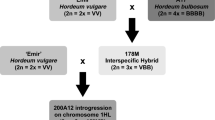Summary
A progeny consisting of 283 anther-derived doubled haploid barley lines from a cross between the winter cultivars lgri (resistant) and Franka (susceptible) was tested for resistance to Pyrenophora teres. A single, dominant gene was detected and tagged by a series of closely linked RFLP markers located in the proximal portion of the long arm of chromosome 3, close to the centromere. Due to the unknown allelic relationship of this gene to another resistance gene previously assigned to chromosome 3, the preliminary designation Pt,,a is proposed. For marker assisted selection RFLP probe cMWG680, which maps 0.8 cM distal to the gene, was converted into a sequence tagged site marker.
Similar content being viewed by others
References
ArabiM.I., A.Sarrafi, G.Barrault & L.Albertini, 1990. Inheritance of partial resistance to net blotch in barley. Plant Breed 105: 150–155.
BockelmannH.E., E.L.Sharp & R.F.Eslick, 1977. Trisomic analysis of several scald and net brotch resistance genes. Barley Genet Newslett 7: 11–15.
BuchannonK.W. & W.C.McDonald, 1965. Sources of resistance in barley to Pyrenophora teres. Can J Plant Sci 45: 189–193.
DyckP.L. & C.W.Schaller, 1961. Association of two genes for scald resistance with a specific barley chromosome. Can J Genet Cytol 3: 165–169.
Foroughi-WehrB. & W.Friedt, 1984. Rapid production of recombinant barley yellow mosaic virus resistant Hordeum vulgare lines by anther culture. Theor Appl Genet 67: 377–382.
GranerA., A.Jahoor, J.Schondelmaier, H.Siedler, K.Pillen, G.Fischbeck, G.Wenzel & R.G.Herrmann, 1991. Construction of an RFLP map in barley. Theor Appl Genet 83: 250–256.
GranerA., H.Siedler, A.Jahoor, R.G.Herrmann & G.Wenzel, 1990. Assessment of the degree and type of restriction fragment length polymorphism in barley (Hordeum vulgare). Theor Appl Genet 80: 826–832.
Graner, A. & A. Tekauz, 1996. RFLP mapping in barley of a dominant gene conferring resistance to scald (Rhynchosporium secalis). Theor Appl Genet (in press).
HartlebH., U.Meyer & C.O.Lehmann, 1990. Das Resistenzverhalten von Saatgersten gegenüber verschiedenen Isolaten von Pyrenophora teres (Sacc.) Shoem. Arch Phytopathol Pflanzenschutz 26: 257–264.
HeunM., A.E.Kennedy, J.A.Anderson, N.Lapitan, M.E.Sorrells & S.D.Tanksley, 1991. Construction of a restriction fragment length polymorphism map for barley (Hordeum vulgare). Genome 34: 437–447.
KeelingB.L. & E.E.Banttari, 1975. Factors associated with the resistance of barley to Helminthosporium teres. Phytopathology 65: 464–467.
KhanT.N. & W.J.R.Boyd, 1969. Inheritance of resistance to net blotch in barley. II. Genes conditioning resistance against race W.A.-2. Can J Genet Cytol 11: 592–597.
KhanT.N. & W.J.R.Boyd, 1970. Genetics of host resistance to net blotch in barley. In: R.A.Nilan (Ed.), Barley Genetics II, pp. 484–492. Washington State University Press, Pullman.
KleinhofsA., A.Kilian, M.A.Saghai Maroof, R.M.Biyashev, P.M.Hayes, F.Q.Chen, N.Lapitan, A.Fenwick, T.K.Blake, V.Kanazin, E.Ananiev, L.Dahleen, D.Kudrna, J.Bollinger, S.J.Knapp, B.Liu, M.Sorrells, M.Heun, J.Franckowiak, D.Hoffman, R.Skadsen & B.J.Steffenson, 1993. A molecular, isozyme and morphological map of the barley (Hordeum vulgare) genome. Theor Appl Genet 86: 705–712.
KosambiD.D., 1944. The estimation of map distances from recombination values. Ann Eugen 12: 172–175.
KuhlmannU. & B.Foroughi-Wehr, 1989. Production of doubled haploid lines in frequencies sufficient for barley breeding programs. Plant Cell Rep 8: 78–81.
LanderE.S., P.Green, J.Abrahamson, A.Barlow, M.J.Daly, S.E.Lincoln & L.Newburg, 1987. MAPMAKER: An interactive computer package for constructing primary genetic linkage maps of experimental and natural populations. Genomics 1: 174–181.
ModeC.J. & C.W.Schaller, 1958. Two additional factors for host resistance to net blotch in barley. Agron J 50: 15–18.
MuirC.E. & R.A.Nilan, 1973. Registration of Steptoe barley. Crop Sci 13: 770.
SchallerC.W., 1955. Inheritance of resistance to net blotch of barley. Phytopathology 45: 174–176.
SchallerC.W. & G.A.Wiebe, 1952. Sources of resistance to net blotch of barley. Agron J 44: 334–336.
Steffenson, B.J., P.M. Hayes & A. Kleinhofs, 1996. Genetics of seedling and adult plant resistance to net blotch (Pyrenophora teres f. teres) and spot blotch (Cochliobolus sativus) in barley. Theor Appl Genet (in press).
TekauzA., 1990. Characterization and distribution of pathogenic variation in Pyrenophora teres f. teres and P. teres f. maculata from western Canada. Can J Plant Pathol 12: 141–148.
TekauzA. & K.W.Buchannon, 1977. Distribution and sources of resistance to biotypes of Pyrenophora teres in western Canada. Can J Plant Sci 57: 389–395.
TekauzA., 1986. Effect of plant age and leaf position on the reaction of barley to Pyrenophora teres. Can J Plant Pathol 8: 380–386.
Author information
Authors and Affiliations
Rights and permissions
About this article
Cite this article
Graner, A., Foroughi-Wehr, B. & Tekauz, A. RFLP mapping of a gene in barley conferring resistance to net blotch (Pyrenophora teres). Euphytica 91, 229–234 (1996). https://doi.org/10.1007/BF00021075
Received:
Accepted:
Issue Date:
DOI: https://doi.org/10.1007/BF00021075




